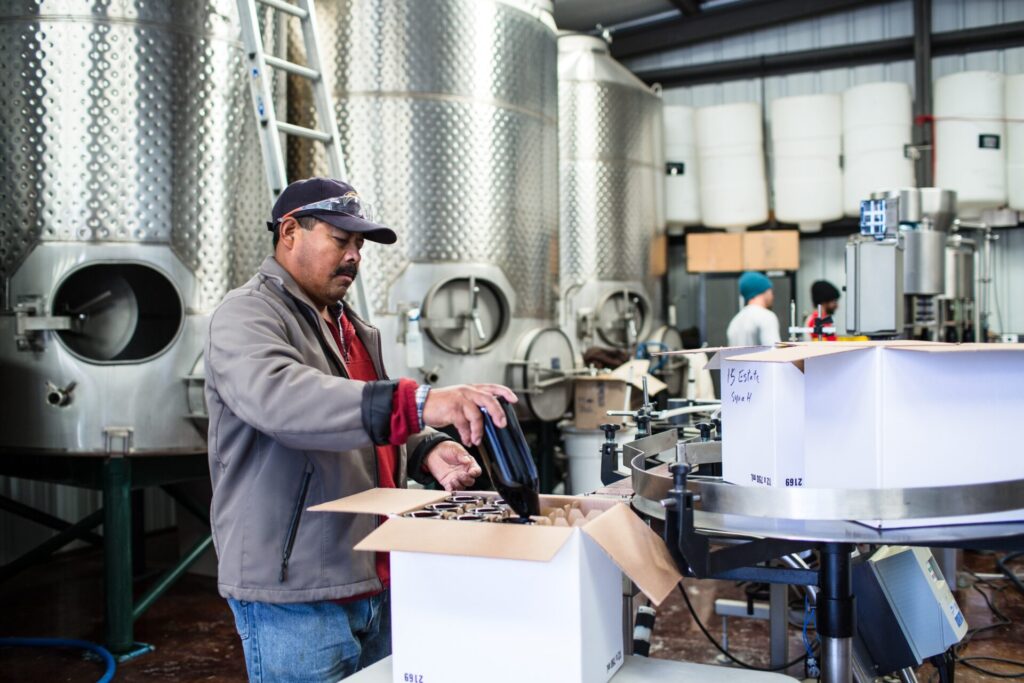How to build a high volume hiring strategy to win talent
High volume hiring is not an easy undertaking for many organizations, especially those in industries with rapid growth or fluctuating seasonal demands. With the need to fill a large number of positions in a short period of time, the pressure to attract and retain qualified candidates can be overwhelming. Plus, poor recruitment strategies can lead to hasty hiring decisions, low employee morale, and ultimately, a less productive workforce.
In this post, we’ll explain how high volume hiring is a crucial part of today’s workforce and reveal how companies that hire large volumes of hourly workers can effectively tailor their recruitment strategies—through innovation and technology—to attract the right caliber of candidates, hire them quickly, and keep their operations running smoothly.
What is high volume hiring?
“High volume hiring” is the process of filling a large number of job openings within a short timeframe. Also known as “always-on” hiring, this type of recruitment is often used by companies across various industries, including retail, hospitality, healthcare, and manufacturing. According to HR.com, nearly three-quarters (73%) of companies engaged in this type of hiring in 2022.
High volume hiring can ebb and flow depending on seasonal demands, rapid business growth, or expansion into new markets. In these cases, organizations need to fill a large number of positions in a short amount of time to meet their business needs.

As opposed to corporate employees, workers who apply for hourly and frontline jobs often follow different timelines and present with a wide variety of skills and experience. Hiring these workers requires a well-planned and organized recruitment strategy, including the use of diverse recruiting methods and technologies, as well as an enhanced focus on candidate experience.
The unique challenges of high volume hiring
Organizations that find themselves needing to scale rapidly in a short amount of time might be faced with manual processes that hinder this desired growth. This slowdown has cost-consuming effects and leads to a loss of talent to competitors with faster systems.
The workflow of a high volume recruiter is different from a traditional recruiter, which is why a traditional ATS doesn’t work. Recruiters in this space need a system that allows them to configure workflows properly, leverage mobile functionalities, and automate manual tasks.
Strategies for improving candidate retention
According to a survey from Aptitude Research, nearly half (46%) of candidates who drop off early in the high volume hiring process did so because of a poor application experience. To help improve this metric, recruiters need to ensure candidates feel connected to the process at every step. Solutions might include video interviews, which enable hiring managers and candidates to connect in real time when it’s convenient for everyone involved.
In addition to video interactions at the interview stage, recruiters would be doing themselves a favor by keeping communication channels open throughout the entire high volume hiring process.
The candidate experience is critical to the success of high volume recruitment. Candidates want to know where they stand in the process, and they expect timely feedback and clear communication. To prioritize the candidate experience, organizations should provide regular updates, schedule interviews promptly, and offer feedback on their candidacy. And if that becomes too time-consuming, it’s necessary to leverage AI communication tools to keep candidates informed.
To maintain clear communication at scale, chatbots are 24/7, desktop and mobile-friendly tools to answer questions, provide information, and engage with users, ultimately converting them to interested candidates.
Automation can help your organization avoid candidate frustrations related to a slow or disorganized hiring process. But to engage candidates further, use personalization in certain aspects of the process, which will show individuals your team is invested in them on a personal level.
Start with the fundamentals of your hiring process
The first step to building a high volume hiring infrastructure is to gather your recruiting team, define clear hiring objectives, and set realistic targets. With so many candidates to manage, recruiters can become overworked and spread too thin. This can lead to burnout, mistakes, and candidate disengagement. To avoid this, organizations should invest in technology and AI tools that can automate manual processes and reduce the workload on recruitment staff.
Get more frontline hiring guidance with our e-book, The Complete Frontline Hiring Guide for Innovative Recruitment.
Essential technology and infrastructure
An ATS that is built to hire high volumes of workers is your best ally for success. For example, smartphone-toting job seekers expect to be able to apply for jobs from their mobile devices. Text-to-Apply allows them to text a keyword to a short code and start the application process right away or at a later time. This keeps applicants engaged while also driving higher conversion rates.
A comprehensive high volume recruiting system also should include robust analytics functions that give recruiters visibility into their processes and can help inform adjustments as hiring needs change over time. By tracking metrics like time-to-hire, cost-per-hire, and applicant source, hiring managers can identify areas for improvement and make data-driven decisions.
Tips for improving the recruitment stage
Although traditional recruiting and recruiting for frontline workers differ in many ways, when it comes to sourcing, the strategies aren’t too dissimilar. The difference, however, is the volume of applicants that high volume hiring teams need to reach.

In addition to the standard job board websites and online ads, recruiters also can leverage their existing staff via social media and through a referral program, encouraging their workers to share openings with their networks in exchange for a bonus.
As far as capturing prospects’ attention, employers need to make sure their brand presents a positive working environment and comes off as a desirable place to work. According to a Fountain survey, more than 64% of job candidates agreed they research a company’s online presence before they apply for a job.
A logical place to start your company’s image makeover? Your careers page. Give it a quick audit to make sure all the information is up to date.
Access an actionable list of high volume hiring best practices by clicking here.
How to integrate hiring software throughout the process
The foundation of any efficient high volume hiring process is a tech-enabled ATS. To determine whether the available ATSes on the market are right for your hiring needs, it’s worth taking a closer look at the features and functionalities of these systems.
The application stage
High volume recruiters can expect hundreds, sometimes thousands of applicants for a single opening, which is great for the pipeline but can be hard on time-to-fill. Automatic application scanners can clip data into sections so it’s easier to process. The more applicant volume you manage, the more necessary this feature becomes. Talent acquisition teams can save countless hours reviewing and comparing applications, reducing time-to-hire and time-to-fill.
Technology also allows recruiters to monitor candidates’ movement through the funnel. A holistic view of all applicants across all job openings provides the flexibility to execute different responsibilities associated with managing a recruiting funnel.
Candidate screening
Artificial intelligence is another asset that can be transformative for high volume hiring. Through AI and machine learning, recruiting teams can process a large number of applications with just a few clicks.
The manual steps involved in high volume hiring, such as data collection and interview scheduling, can be time-consuming and prone to errors. To improve efficiency and reduce the workload on recruitment staff, organizations should automate as many manual processes as possible. This can include using AI-powered technology or natural language processing (NLP) tools to collect and store candidate data, schedule interviews, and provide feedback to candidates. This also can help eliminate bias and standardize processes so they’re consistent across the board.
Click here to learn how to equip your organization for the digital HR transformation.

Assessments
Including assessments in the hiring process can be a great way to determine if candidates are right for your role while weeding out those who might not be a great fit. With AI-powered assessments that are automatically triggered based on the candidate’s location in the funnel, initiating assessmnets can be a very light life for recrutiing teams.
Onboarding
Once a candidate is hired, a high volume hiring process that is enabled by AI and automation can assist with onboarding tasks, like sending information on company policies and procedures, providing links to training materials, answering common questions, and even conducting virtual onboarding sessions.
Learn more about how AI can help your recruitment team work smarter.
Updating your hiring workflows
A customizable hiring process allows recruiters to make changes on the fly, such as dragging and dropping various stages of the hiring workflows depending on your hiring needs.
While most high volume hiring software requires customer support for workflow adjustments, today’s frontline applicant tracking systems come equipped with customizable workflows that can be tweaked directly by hiring teams.
Case study: Videos keep the human connection alive
Bojangles, a Fountain customer, experimented with using video interviews to hire high volumes of candidates for their fast food chicken restaurants. But before Fountain, Bojangles was focused on increasing the speed of application flow, decreasing time-to-hire, and, most importantly, creating the best candidate experience possible.
Fountain enabled Bojangles to maintain the human connection through video. Once a candidate schedules an interview, Bojangles automatically plays a video that has been prerecorded by the general manager of that specific location. In the video, the GM welcomes the applicant to the process and expresses their excitement about speaking further about the job opportunity.
By prioritizing the candidate experience and maintaining the human connection, applicants tend to stay engaged in the process and are less likely to drop off or ghost the hiring manager.
High volume hiring: Final thoughts
By leveraging technology, optimizing sourcing efforts, prioritizing the candidate experience, and tracking key metrics, HR staff can improve the efficiency and effectiveness of the recruitment process for hourly workers. By doing so, businesses can attract and retain top talent, improve operational efficiency, and ultimately drive better business results.
To learn more about high volume hiring and how it can benefit your hourly recruitment process, click here to read the Digital Transformation Guide for High Volume Hiring.

